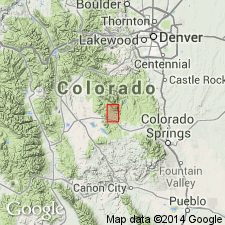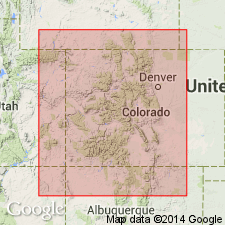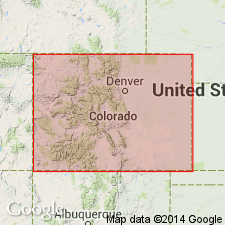
- Usage in publication:
-
- Redskin Granite*
- Modifications:
-
- Named
- Geochronologic dating
- Dominant lithology:
-
- Granite
- AAPG geologic province:
-
- Southern Rocky Mountain region
Summary:
Named for Redskin Gulch, eastern Park Co, CO in the Southern Rocky Mountain region. Previously called Redskin Gulch granite stock by Hutchinson (1964) and the late facies of the Pikes Peak Granite by Hawley (1963, 1964). Type area is the area occupied by the Redskin stock. Crops out in northern part of the Lake George area in the Redskin stock and in the China Wall and Boomer cupolas. Composed of white to pink, fine- to medium-grained massive granite. The aplitic and pegmatitic facies are locally miarolitic. The stock is concentrically zoned. The core or central zone is fine-grained equigranular granite or a fine-grained facies. A medium-grained seriate porphyritic facies surrounds the core. Medium-grained equigranular granite or granular facies forms the outer core. All three facies are composed of microcline that is variably perthitic, quartz, albite, and mica. The fine-grained and porphyritic types are two-mica granites containing quartz, microcline, and albite in equal proportions. Is considered epizonal because of its occurrence in discordant plutons, its massive structure, and local miarolitic facies. Is about 1,000 m.y.; K-Ar ages are: biotite, 980 m.y.; muscovite, 990, 1,000, and 1,020 m.y.. Rb-Sr ages are microcline, 915 +/-50 and 950 +/-50 m.y. Is younger than the Pikes Peak Granite.
Source: GNU records (USGS DDS-6; Denver GNULEX).

- Usage in publication:
-
- Redskin Granite*
- Modifications:
-
- Overview
- AAPG geologic province:
-
- Southern Rocky Mountain region
Summary:
Is a granite in a stock within the composite Pikes Peak batholith. Listed with granitic rocks of circa 1,000 m.y. (or Precambrian Y) age group.
Source: GNU records (USGS DDS-6; Denver GNULEX).

- Usage in publication:
-
- Redskin Granite*
- Modifications:
-
- Overview
- AAPG geologic province:
-
- Southern Rocky Mountain region
Summary:
Is a red to pink, alkali granite with muscovite and biotite. Occurs as an oval stock about 50 sq km (19 sq mi) in extent and two small satellitic bodies at west margin of Pikes Peak batholith, CO, Southern Rocky Mountain region. The stock is concentrically zoned with an outer zone of granular granite, intermediate zone of porphyritic granite, and inner (and youngest) zone of fine-grained granite. Muscovite content increases inward in the stock. Intruded into two different units of Pikes Peak batholith--the Tarryall Mountains and Tarryall Creek batholiths. Assigned to the Middle Proterozoic.
Source: GNU records (USGS DDS-6; Denver GNULEX).
For more information, please contact Nancy Stamm, Geologic Names Committee Secretary.
Asterisk (*) indicates published by U.S. Geological Survey authors.
"No current usage" (†) implies that a name has been abandoned or has fallen into disuse. Former usage and, if known, replacement name given in parentheses ( ).
Slash (/) indicates name conflicts with nomenclatural guidelines (CSN, 1933; ACSN, 1961, 1970; NACSN, 1983, 2005, 2021). May be explained within brackets ([ ]).

